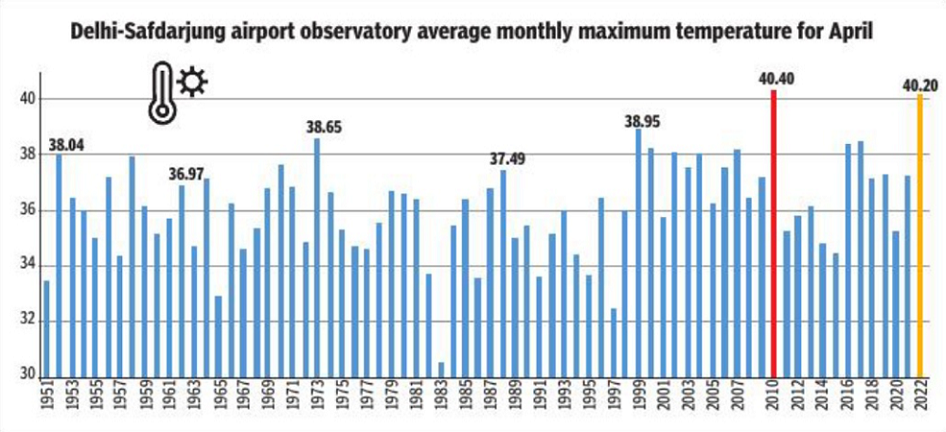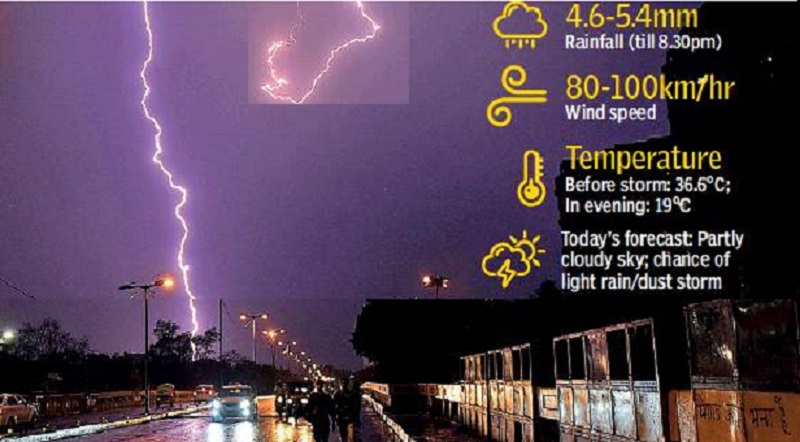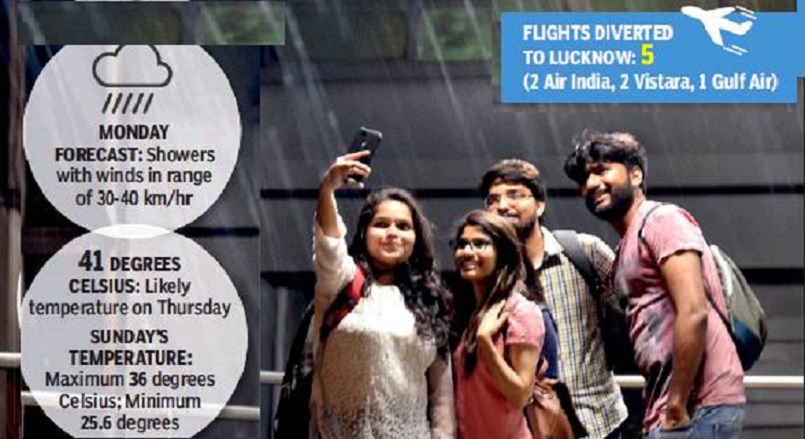April weather in India
This is a collection of articles, mainly from the Delhi- based press. |
This page is under construction. Data will continue to be added over the next several years.
April as a whole
Days with extreme heat
2021>2022
June 11, 2022: The Times of India
New Delhi: A report by Greenpeace India on heatwave has said days with extreme heat in April 2022 increased in Delhi by 122% compared with April 2021. The report has claimed that the ongoing heatwaves and other extreme weather events show that the proclaimed “safe limit” of climate change has already been crossed and it is already a “climate crisis”. Greenpeace India has analysed data acquired from Accuweather to study the average increase in temperatures over April in 10 capital cities of India. Cities located in both plains and hilly regions have shown a drastic increase in the intensity of heatwaves, while coastal cities have fared relatively better. Delhi, Lucknow, Jaipur, Bhopal and Shimla have registered maximum numbers of hottest days above 43 degrees Celsius. According to the report, Delhi recorded the highest maximum temperature range of 40-44 degrees Celsius in April 2022 compared with 40-42 degrees Celsius in April 2021. It recorded temperatures above 40 degrees Celsius after April 6 while the same was observed after April 12 last year. In 2022, such temperatures were experienced for 20 days as opposed to nine days in 2021. Bhopal and Shimla witnessed 183% rise in days with extreme heat over April 2021, while Lucknow, Jaipur and Patna saw 145%, 136% and 27% rise, respectively. “All the cities are capital cities, which are growing in terms of population and undergoing increased industrialisation. This results in a hike in emissions of greenhouse gases, ultimately contributing to global warming and resulting in large variations in temperature,” the report stated.
It highlighted various im- pacts of heatwaves on human health such as heat exhaustion, heatstroke, life-threatening complications, and worsening of pre-existing conditions. The rising temperatures have an economic cost, too, resulting from crop failures, food insecurity and loss in total working hours. It said the rising temperatures on the Earth accompanied by weat- her changes had an adverse effect on the biodiversity.
Avinash Kumar Chanchal, campaign manager of Greenpeace India, said, “We are now living amid a deteriorating climate crisis, and we need just and equitable responses. Apart from governments and corporations focusing on adaptation and mitigation measures required to deal with climate change, we will require measures specific to increa- se the adaptability of the population during extreme events like heatwaves in India. ”
He added, “These responses need to include effective communication, efficient warning systems, special response for vulnerable populations, increase in green cover and conservation of waterbodies in our cities. We need practical solutions, and we need them now. ”
Hottest (and merely very hot) days of the month
India
Monthly average maximum, minimum temperatures
1951-2022
See graphic, Monthly average maximum temperatures in India in April, 1901-2022
In election years: 2004-2024
The average maximum April temperature in India in election years
35.7°C in 2019
35.6°C in 2024
35°C in 2004
35.5°C in 2009
35.3°C in 2014
2024: 2nd hottest April ever in South/ East India: mean temp highest since 1973
Amit Bhattacharya, May 1, 2024: The Times of India
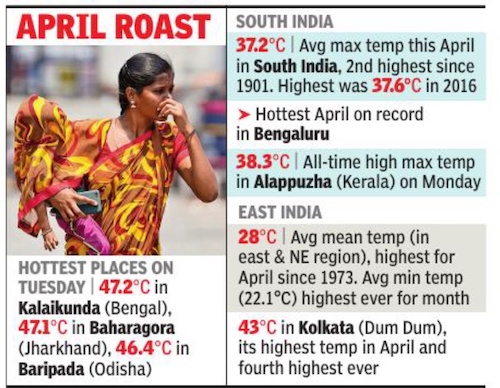
From: Amit Bhattacharya, May 1, 2024: The Times of India
South India experienced its second hottest April on record in terms of maximum temperatures while the average mean temperature in east and northeast India was the highest for the month in 51 years, IMD data reveals, attesting to the torridly hot conditions that these regions have been witnessing over the past few weeks.
The last few days have seen heat records fall in three of biggest cities — Bengaluru, Kolkata and Mumbai.
The South as a whole recorded an average maximum temperature of nearly 37.2 degrees Celsius during the month — surpassed only by 37.6 degrees C logged in April 2016 in records going back to 1901 — IMD’s monthly temperature data reveals. Bengaluru witnessed its hottest ever April. The metro, once famous as the Garden City, recorded 13 extremely hot days, including six in a row, during the month.
Eastern India has been baking in April heat during a prolonged spell of extreme weather. As per IMD’s data, the average mean temperature in the region (east and NE, as per IMD classification) during the month was the highest since 1973, with the average night temperatures the highest ever in April. Bengal, Jharkhand and Bihar have been reeling under extreme heat. On Tuesday, Kolkata (Dum Dum) logged 43 degrees C, its highest temperature in April and fourth highest for any month.
Mercury crosses 47° for 1st time this yr
It was43°C at Kolkata’s Alipore as well, less than a degree from the all-time high of 43.9°C recorded almost a century ago and only the second time ever that Kolkata’s April temperature had touched the 43°mark.
Meanwhile, for the first time in the country this season, the mercury crossed the 47°mark on Tuesday — Kalaikunda in (Bengal) logged 47.2°C, a whopping 10.4°above normal, and Baharagora in East Singhbhum district of Jharkhand touched 47.1°C. At least three spots in the region — Kalaikunda, Panagarh (Bengal) and Balasore (Odisha) — reported temper- atures 10°higher t han normal.
Odisha, which falls under central India in IMD’s classifi- cation, has been reeling under aheat wave for 16 straight days. “This is the highest number of consecutive days of heat wave in Odisha in 10 years. The record for the longest heat wave spell in the state is 26 days, reported in 1998,” said Mrutyunjay Mohapatra, chief of IMD.
“The heat waves in several parts of the country weren’t entirely unexpected. El Nino continues to persist in the Pacific and under this condition, south India and adjoining areas are known to witness above normal temperatures in April. A more immediate reason for the heat in eastern India is the presence of an anti-cyclonic circulation in central Bay of Bengal, which is preventing sea breeze from entering the region. As a result, the land has become dry and hot,” Mohapatra said. Another wind circulation, an anti-cyclone over western Arabian Sea, has been pumping up heat along the western coast, particularly the Konkan belt, over the past few days. On Monday, the temperature at Mumbai’s Santa Cruz crossed 39° for the second time this month, making it the second hottest April day in the city in 10 years.
IMD expects the heatwave to continue in eastern India till May 2 and for at least another five days in the South. With inputs from Niranjan Kaggere in Bengaluru, Sumati Yengkhom in Kolkata
City records
2022
See graphic: The highest temperatures ever recorded in several Indian cities in April were in 2022.
Delhi
April as a whole
Average monthly maximum temperature
40.4 degrees Celsius in 2010 April (highest since 1951)
40.2 degrees Celsius in 2022 April
36. 3 degrees C: normal maximum temperature in April
Heatwaves, 2011-2022
Also see the graphic, The number of heatwave days at Safdarjung, Delhi, in April, 2011- 22
2011 and 2015: No heatwave day was recorded at Safdarjung in April.
2016: saw only one heatwave day in April.
2017 April had four heatwave days
2018 to 2021: no heatwave was recorded at Safdarjung in April.
2022: In April, Safdarjung recorded nine heatwave days, the streak beginning in the second week of the month.
Individual April days
43.2 degrees Celsius 2017 April: maximum at Safdarjung.
42. 4 degrees Celsius, April 9, 2022; the highest temperature recorded in the first half of April in 72 years and the highest for the whole of April since 2017
Gurgaon
Highest April temperature on record The India Meteorological Department started recording Gurgaon’s weather data from 1969.
45. 9 degrees C 29 Apr 2022
45. 6°C 28 Apr 2022
44. 8 degrees April 28, 1979.
Guwahati
40.1 degree Celsius GUWAHATI, April 1999 India Today June 21, 2014
Delhi
2011-20
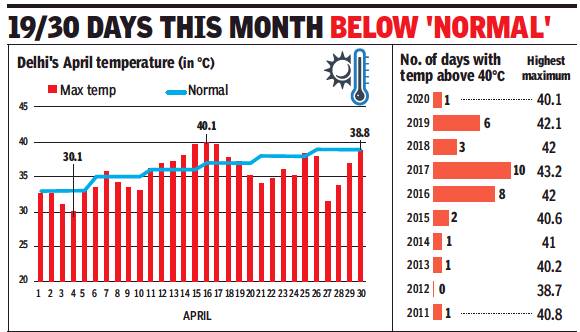
Day-wise temperatures in Delhi in April 2020
From: 3 reasons why this April wasn’t as warm as usual, May 1, 2020: The Times of India
See graphic:
April temperatures in Delhi, 2011-20
Day-wise temperatures in Delhi in April 2020
2020, 2222, 2023, 2024
Kushagra.Dixit/ Fewer 40°C Days, But April Warmer Than Previous Year/ The Times of India
Lack Of Rain Has Prevented A Significant Drop In Mercury
Apr 2024: The city has experienced an average maximum temperature of 37 degrees Celsius this month — slightly above the long-term average for the month and higher than 2023 April’s average — despite surpassing the 40-degree Celsius mark only on one day.
According to the India Meteorological Department (IMD), there have been numerous days with temperatures around 38 and 39 degrees. The lack of rainfall has prevented a significant drop in mercury.
“This April, there were around five western disturbances, but they were all feeble and couldn't make a major impact on the capital. However, it caused rain in the mountains. If there were showers, then it was mostly towards late evening or after the maximum temperature had been recorded. So the temperatures did not drop that significantly and daytime remained largely warm. However, despite the western disturbances being weak, strong winds and clouding prevented the daytime temperature from crossing 40 degrees Celsius that often. The city saw winds of around 20-30 kmph for at least 15-16 days in April this year,” said Kuldeep Srivastava, a scientist at IMD.
The city recorded 7.5 mm of rainfall till April 29, which is likely to end the month in a rain deficit, similar to March (4.3 mm). The long-period average (LPA) for rainfall in April is 16.3 mm, while it is 17.4 mm for March.
2023: , Delhi experienced cooler temperatures at the beginning of April, with temperatures dropping below 30 degrees Celsius, but it had four days with temperatures of 40 degrees Celsius or higher. The year 2022 saw an exceptional 16 days in April when the maximum temperature exceeded 40 degrees Celsius.
In 2020, the maximum temperature crossed the 40-degree threshold only on one day in April. The monthly average maximum then was 35.3 degrees Celsius.
In 2023, the highest maximum temperature in April was 40.6 degrees Celsius, while in 2022 it was 43.5 degrees Celsius, and in 2021 it was 42.2 degrees Celsius. 2024 , the mercury crossed the 40-degree mark only once, on April 26, reaching 40.5 degrees Celsius.
Cool Aprils
Lowest minimum/ maximum temperatures recorded in April
India
Neha.Madaan, The Times of India
The average maximum temperature in April in India
33. 9°C in April 2020
34. 1°Celsius in 2023
34. 5°C in 2021.
35. 3°C in 2022
The average minimum temperature in India in April
22. 08°C in 2023
22. 32°C in 2021,
22. 36°C in 2020,
22. 58°C in 2018.
22. 8°C in 2019
23. 5°C in 2022,
Delhi
(All temperatures mentioned were recorded at the Safdarjung station unless stated otherwise)
10.6 degrees Celsius at Lodhi Road, April 2, 2021
10.7 degrees Celsius at Safdarjung, April 2, 1965.
11.? °C in April 2009.
11.7 degrees Celsius, 2 April 2021 —seven notches below normal for that time of the season.
Other random ‘lows’ for particular years:
14.4 degrees, the lowest minimum recorded in April 2020
16.2 degrees Celsius, the lowest minimum recorded in April 2019.
2020/ Delhi
Jasjeev Gandhiok, 3 reasons why this April wasn’t as warm as usual, May 1, 2020: The Times of India
In the past, temperatures in the capital have often crossed the 40 degrees Celsius-mark in April. As recently as in 2017, it touched 43.2 degrees Celsius. However, this year, April’s weather sprung a pleasant surprise. The capital recorded only one day when the temperature touched the 40-degree mark — on April 16 when Safdarjung recorded a high of 40.1degrees Celsius.
Delhi recorded more days below the ‘normal’ mark this April compared with the days where the temperature was ‘above’ normal. As many as 19 out of 30 days were below the normal mark, with the maximum falling as low as 31.4 degrees Celsius on April 27 — seven degrees below normal. Met officials say a spell of western disturbances, gusty winds and rain have kept Delhi’s temperature under check, not allowing it to rise too rapidly. The month also witnessed more western disturbances than normal — six, as compared to four generally seen in April.
The monthly average at 35.5 degrees Celsius is also nearly one degree below the ‘normal’ monthly average mark of 36.3 degrees Celsius.
Kuldeep Srivastava, scientist at IMD, told TOI that a spell of western disturbances in April did not allow the temperature to rise too rapidly. This could continue in the early part of May as well.
“We’ve received more western disturbances than usual and while only 3-4 brought rain, each western disturbance made the skies overcast and brought down the temperature,” said Srivastava. The temperatures were lower only in April 2012, when the capital recorded no days in April above the 40-degree mark.
Delhi recorded light showers on April 30, 2020 as well in some areas, making it six rainy days in the month of April. This was accompanied with gusty winds ranging from 30-40 km/hr in parts of the capital.
1st April
2nd April
3rd April
Delhi, hot at 36.8°C mx, 17.6°C mn/ 2019
Delhi sweats as mercury continues to rise, hits 36.8°C | The Times of India
It was another hot day on Wednesday when the maximum temperature touched 36.8 degrees Celsius — three notches above normal. The minimum was 17.6 degrees Celsius, one degree below normal. TNN
4th April
Delhi, Safdarjung 39°C, Palam 40.1°C/ 2018
2018 At 39°C, city sees warmest day of this season
TIMES NEWS NETWORK
New Delhi: If the warmest March in the last eight years was a sign of things to come, the capital saw its highest maximum temperature of the season on Wednesday with the mercury touching 39 degrees Celsius — five notches above normal.
Palam was the hottest location with a maximum temperature of 40.1 degrees Celsius.
“This has been the warmest day of the season..
Delhi had recorded its warmest day of the season on March 28 when the maximum temperature was 38.6 degrees Celsius, also making it the warmest March in the past eight years. Overall, last month was also the warmest in the last eight years with respect to the average maximum temperature of 3.3 degrees Celsius — over normal for the season.
Other parts of the city also witnessed similar heat on Wednesday with Palam recording 40.1 degrees. Ayanagar and Ridge recorded a maximum of 39.6 and 39.3 degrees Celsius, respectively.
Delhi, north India: heatwave; Safdarjung 38.2°C, outer Delhi 40°C/ 2019
Heatwave in capital, brace for hottest day today | The Times of India
Parts of Delhi recorded heatwave conditions on Thursday with the mercury crossing 40 degrees Celsius at certain locations. Delhi’s maximum temperature at Safdarjung — which is considered as base for Delhi’s weather — was meanwhile recorded at 38.2 degrees Celsius, five degrees above normal for this time of the season.
“Temperature in northern India is currently 5-6 degrees Celsius above normal in most places. Warm winds from the south are blowing towards Delhi,” said BP Yadav, IMD’s regional Met head.
5th April
Delhi: Dust storm, rain hit airline, metro operations / 2018
2018: Dust storm, rain blow away heat spell/ Reduce Visibility, Fell Trees And Throw Traffic Out Of Gear
Jasjeev Gandhiok & Somreet Bhattacharya TNN
New Delhi: After a lengthy spell of sweltering heat that saw the mercury rising inexorably to the 40 degree Celsius mark this past week, respite came for Delhi’s citizens on Friday in the form of a robust dust storm and light rain. The sudden change in weather occurred around 5pm when dust-laden winds started billowing in the capital and surrounding areas, reducing visibility drastically in most areas.
The strong winds felled at least 11trees in different parts of the city and caused major traffic snarls in central, east and south Delhi. Trees were uprooted near Karol Bagh, Kalkaji temple, Okhla, Jhandewalan, Akshardham, Baljeet Nagar, Prem Nagar, Kasturba Gandhi Marg, Gyarah Murti and Yamuna Vihar, affecting vehicle movement on the Noida Link Road, Outer Ring Road, Ring Road and DBG Road. There were reports of disruptions in Delhi Metro and flight services too.
Officials from the Regional Weather Forecasting Centre (RWFC) described the weather activity as pre-monsoon thunderstorms, normal for the month of April.
By 8.30pm, Safdarjung Observatory, whose readings form the base for Delhi’s weather record, had logged 4.6mm of rainfall, while Palam recorded 5.4 mm. The maximum temperature for the day before the rain was 36.6 degrees Celsius and the minimum, 22.5 degrees Celsius, which rapidly slid down to 19 degrees in many areas after the rain.
Srivastava explained that the dust storm occurred due to a high variation in the pressure gradient across Delhi, resulting in strong winds blowing from the west. “Rajasthan had similar weather activity on Thursday night and the north-west winds moved towards Delhi due to a lowpressure trough. Haryana and other parts in the region also witnessed similar weather, which generally begins in April,” the scientist said.
2018: Bad weather wrecks airline, metro operations
TIMES NEWS NETWORK
New Delhi: The sudden change of weather on Friday evening brought respite in terms of heat, but it affected both flight and Delhi Metro operations on a large scale. Indira Gandhi International (IGI) airport reported 24 flight diversions between 5.30pm and 7.30pm due to poor weather, while over 100 flights were delayed. Metro operations were affected on the Pink and Blue lines.
Airport Met officials said flight operations were partially affected for roughly two hours from 5.20pm onwards with visibility coming down to 900 metres around 5.30pm. Visibility improved to 1,500m when rain started. Wind speeds ranged between 60-70 kmph during this period.
Commuters complained of slow moving trains and arriving at frequency of 20-30 minutes even during peak hours. Blue Line (Dwarka Sector 21-Noida City Centre/Vaishali) saw major disruptions and stations such as Rajiv Chowk and Mandi House were packed with passengers.
Delhi, 39.3°C mx, 20°C mn/ 2019
Friday was the hottest day of the season yet as the maximum temperature touched 39.3 degrees Celsius, five notches above normal.
The previous highest this season was on March 30 when the maximum was 39.2 degrees Celsius. This was the warmest March day in nine years after March 22, 2010. The minimum on Friday was 20 degrees Celsius, one point above normal.
Uttarakhand, 33/ 17.9°C Dehradun; 23.6/11.1°C Mukteshwar/ 2019
Light rain & thunderstorm likely today| 05 April 2019 | PNS | Daily Pioneer
After a rise in temperature for about a week now, the maximum and minimum temperatures recorded at various places in Uttarakhand were 33 degree Celsius and 17.9 degree Celsius respectively in Dehradun, 33.4 degree Celsius and 17 degree Celsius in Pantnagar, 23.6 degree Celsius and 11.1 degree Celsius in Mukteshwar and 22.4 degree Celsius and 13 degree Celsius in New Tehri respectively.
6th April
Delhi: 38.7°C mx, 22.4°C mn/ 2019
Dust storm, light rain may bring slight relief from heat today | The Times of India
It was another hot day in the city on Saturday as the maximum temperature reached 38.7 degrees Celsius, four notches above normal. The minimum temperature was 22.4, also three degree Celsius above normal.
7th April
Delhi, 36°C mx/ 25.6°C mn, 0.1mm rain, then thunder showers/ 2019
After a relatively hot day, the capital was swept by a dust storm followed by thunder showers in the evening. The evening showers also helped the mercury return close to the normal mark.
The evening downpour also led to five flights being diverted from the IGI airport. “There were five diversions — 2 Air India, 2 Vistara and 1 Gulf Air flight — between 8pm and 10pm. The flights were diverted to Lucknow airport,” said an airport official.
Delhi’s maximum temperature was recorded at 36° Celsius on Sunday — one notch above normal for this time of the season. The minimum temperature, meanwhile, was 25.6 degrees — six notches above the normal for this time of the season.
Officials said trace amount of rainfall was also recorded in the last 24 hours at Safdarjung and Ridge, while Lodhi Road recorded 0.1mm of rainfall before the Sunday evening downpour.
Ayanagar was the hottest location in Delhi on Sunday with a maximum of 39.3 degrees Celsius.
8th April
9th April
Delhi, 3.4mm rain, thunderstorm, 31.4°C mx/ 20°C mn/ 2018
2018: Delhiites woke up to a rainy morning on Monday, with light to moderate showers bringing the maximum temperature down by 3-4 degrees Celsius.
Thunderstorm, accompanied by rain, led to traffic snarls and waterlogging on a number of stretches. Met officials have forecast similar activity in the next two days, which will keep the maximum temperature around 30 degrees Celsius.
Delhi’s Safdarjung observatory, taken as the base for weather in the capital, recorded 2.2mm of rainfall till 8.30am and another 1.2mm of rainfall in the next nine hours. Meanwhile, places like Palam, Lodhi Road and Ayanagar recorded 0.4, 1.1 and 0.4mm of rainfall till 8.30am. Relative humidity at the time was around 66%.
Officials from the Regional Weather Forecasting Centre (RWFC) said the capital is likely to see light rain and thunderstorm activity on Tuesday and Wednesday. “Tuesday will see thundershowers, accompanied by squall, around the afternoon or evening. Wednesday will also see thunderstorm and rain, which will keep the maximum temperature 3 to 4 degrees below normal. The rain is a result of an active western disturbance in Jammu and Kashmir,” said an RWFC official, adding that it was normal pre-monsoon thunderstorm activity for this time of the season.
Delhi’s maximum was recorded at 31.4 degrees Celsius, three notches below normal, and the minimum was around 20 degrees, officials said.
10th April
11th April
Delhi: drizzle, thunderstorm; 33.4°C mx/ 2018
2018: After spell of rain, temp to reach 40°C by next week
TIMES NEWS NETWORK
New Delhi: The capital witnessed drizzle and thunderstorm in several parts on Wednesday. The maximum temperature was recorded at 33.4 degrees Celsius — three degrees below normal for the season.
Regional Weather Forecasting Centre (RWFC) officials said the effects of the drizzle would be short-lived.
“The capital saw a trace of rain on Wednesday with drizzle reported from several parts of the city,” said Kuldeep Srivastava, scientist, RWFC.
The Safdarjung observatory recorded light drizzle before 8.30am on Wednesday, while weather stations at Palam, Lodhi Road and Ridge saw similar drizzle between 8.30am and 5.30pm. The maximum temperature at Safdarjung was 33.4 degrees Celsius, while the minimum was 23.6 degrees, officials said.
Delhi saw duststorm and rain on April 6, following which temperatures remained below normal. Early morning rains were also recorded on Monday with the maximum temperature recorded around 33 degrees Celsius.
12th April
UP, Rajasthan: Severe storm/ 2018
2018 Severe storm leaves 42 dead in UP, Raj
TIMES NEWS NETWORK
Agra/Alwar/Jaipur: A four-hour-long storm with very strong winds and heavy rain claimed 42 lives and left a trail of destruction in west Uttar Pradesh and east Rajasthan on Wednesday night.
Most of the dead, which included many children, were victims of house collapses as the storm swept through UP’s Agra, Mathura and Firozabad districts before lashing Bharatpur and Dholpur in Rajasthan. “Most of the deaths were due to walls of houses coming down. At many places, the victims were asleep,” said a senior officer. At least 200 people were injured and around 600 electricity poles came down.
Storm hits movement of trains through Agra, Mathura
Due to snapped power lines at many places, large areas in UP remained in darkness. The rooftop of Agra’s UP dial 100 control room fell off in the storm, injuring one cop and damaging communication lines.
The storm also affected movement of 25 trains passing via Agra and Mathura.
Dozens of cattle were killed — at least 40 in Agra, including buffaloes and sheep, and over 50 in Firozabad.
13th April
14th April
15th April
Delhi: 40°C mx/25.5°C mn, 2019
Mercury at 40°C, rain may bring relief | The Times of India
The mercury touched 40 degrees Celsius — three notches above normal — the highest yet this season. Previous highest this season was 39.3 degrees Celsius recorded on April 5.
The minimum temperature on Monday was 25.5 degrees Celsius, five degree above normal at this time of the year.
16th April
All India: Heat wave 44.8°C/ rain- thundershowers/ cold in different parts
UNI| Thunderstorm likely in J&K, other parts of country
PUNE, Apr 16: Day temperatures were above normal in some parts of Odisha, Haryana, Chandigarh and Delhi, Gujarat Region, madhya Maharashtra, Marathwada, coastal Andhra Pradesh, Telangana, Rayalaseema, south interior Karnataka, Assam, Meghalaya, west Uttar Pradesh, east Rajasthan, Madhya Pradesh, Tamil Nadu and Kerala.
Day temperatures were appreciably above normal in some parts of Jharkhand, Uttar Pradesh, Punjab, east and west Rajasthan, Madhya Pradesh, Konkan and Goa, Vidarbha, Tamil Nadu, Kerala, Saurashtra and Kutch and were markedly above normal in some parts of Uttarakhand, Himachal Pradesh, Jammu and Kashmir and Saurashtra and Kutch.
Day temperatures were below normal in some parts of Sub-Himalayan West Bengal and Sikkim, west Rajasthan and were appreciably below normal in some parts of Assam and Meghalaya.
Day temperatures were normal over rest of the country.
The highest maximum temperature recorded over the plains was 44.8 degrees celsius in Chandrapur of Vidarbha.
Heat waves swept across isolated places in east Madhya Pradesh.
Hailstorm observed at isolated places in Pune on Monday evening.
Thunderstorms occurred at isolated places in Assam, Meghalaya, Nagaland, Manipur, Mizoram, Tripura, Gangetic West Bengal, Odisha, west Uttar Pradesh, Haryana, Chandigarh and Delhi, Rajasthan, Madhya Pradesh, madhya Maharashtra, Marathwada, Vidarbha, Chhattisgarh and north interior Karnataka and Kerala.
Rain or thundershowers have occurred at many places in Assam, Meghalaya and at isolated places in Nagaland, Manipur, Mizoram, Tripura, Sub-Himalayan West Bengal and Sikkim, Punjab, Jammu and Kashmir, east and west Rajasthan, madhya Maharashtra, Marathwada, Andaman and Nicobar Islands, Odisha, west Uttar Pradesh, Haryana, Himachal Pradesh, Madhya Pradesh, Vidarbha, Chhattisgarh, Saurashtra and Kutch, Konkan and Goa, Telangana, Tamil Nadu and interior Karnataka and Kerala.(UNI)
Delhi: 40°C, 2018
2018: Temp touches 40°C, but rain to bring relief
The Times of India
Summer in the capital may well and truly be here with the maximum temperature touching 40 degrees Celsius for the first time this season on Monday.
Safdarjung – the weather station taken as the base for Delhi’s weather — recorded the temperature at 40°Celsius, three notches above normal while it reached a season-high of 41.6 degrees Celsius at Palam.
Officials at the local met office attributed the rise in temperature to a change in wind direction and clear skies.
“Westerly and north-westerly winds have resulted in the sudden rise in temperature.,” said Kuldeep Srivastava, scientist at the met office.
Delhi, thundershowers, 30.7/20.5°C; 1.1mm rain/ 2019
Winds and thundershowers cool city, but air quality likely to worsen | The Times of India
Thundershowers and gusty winds struck the capital on Tuesday evening, with spells of light rain recorded in different parts of NCR. The maximum temperature fell by almost 10 degrees Celsius since Monday — settling at 30.7 degrees Celsius, six notches below normal for this time of the season. Overcast skies prevailed for most part of the day, accompanied by windy conditions.
“An active western disturbance has brought rain and dust storm activity to parts of northern India. A lot of the activity occurred overnight while a spell also was recorded on Tuesday evening,” said a senior met official.
The regional met department said 1.1mm of rainfall was received until 8.30am on Tuesday, while another 0.2mm of rainfall was recorded in the next nine hours. Other locations in Delhi too received light rain with Palam, Lodhi road, Ridge and Ayanagar recording 0.2, 0.6, 0.8 and 0.4mm of rainfall respectively in the morning.
The change in maximum temperature variation since Monday was almost 12 degrees at the Ridge station, which had a maximum of 41.9 degrees on Monday, while it fell to 29.6 degrees Celsius on Tuesday. Delhi’s minimum temperature was also recorded below normal, settling at 20.5 degrees Celsius as relative humidity oscillated between 47% and 83%, officials said.
Rajasthan, MP, Gujarat: thunderstorm and 31 deaths, 2019
In Rajasthan, gusty winds triggered by Western Disturbance affected normal life in several areas. Chittorgarh, Sriganganagar, Ajmer, Kota and Pilani received heavy rainfall, according to the Met department.
Thirty-one people were killed in three states as rain and thunder storm caused by western disturbance hit parts of north India on Tuesday causing damage to property and crops, reports ANI.
While 16 people died in Madhya Pradesh, six deaths were reported from Rajasthan and nine from Gujarat.
In Rajasthan, gusty winds triggered by western disturbance affected normal life in several areas. Chittorgarh, Sriganganagar, Ajmer, Kota and Pilani received heavy rainfall, according to the Met department. “Western Disturbance and winds with moisture from Arabian sea and Bay of Bengal are developing this kind of weather conditions. Gusty winds are causing dust storm mainly in Western parts of the state because the soil is loose and there is lack of moisture there,” a Met official said.
Thunderstorm also occurred in eastern parts of the state and similar weather conditions are most likely to prevail till Tuesday night.
In Gujarat, a dust storm damaged part of a tent being erected for Prime Minister Narendra Modi’s April 17 rally in Himmatnagar town in Sabarkantha district of Gujarat.
Some covering material of the structure was either blown away or torn apart, local BJP leaders said, adding that the structure, which is intended to provide shade to people and dignitaries on stage, remained largely intact.
17th April
Delhi: 29.5°C/ 19°C/ 2019
Delhiites enjoyed a cool, overcast day with light drizzles and maximum temperature of 29.5°C, 7 degrees below normal. The minimum was 19°C, 3 degrees below normal.
Guj, MP, Raj/ dust-, thunderstorms; toll rises to 59; 2019
59 killed as thunderstorms unleash fury in Raj, MP, Guj | The Times of India
Dust and thunderstorms swept through west, central and north India as a major weather disturbance pummelled the region over the past 48 hours, claiming the lives of at least 59 people, a majority of them in Rajasthan and Madhya Pradesh.
Most of the deaths were due to lightning strikes, electrocution and tree falls, reports said. Rajasthan reported 25 deaths, Madhya Pradesh 21 and Gujarat 10, while three people died in Maharashtra since Monday. There were also reports of damage to crops due to strong winds, rain and hailstorms in Madhya Pradesh, Punjab and elsewhere.
Jammu region: hailstorm, 20.1/16.4°C/ 2019
JAMMU, Apr 17: With massive rain across the region since yesterday, Jammu’s temperature has recorded a sharp fall of nearly 13 degrees Celsius below normal while thunder and hailstorm caused extensive damage to the crops of the farmers in Jammu, Samba, Udhampur and Kathua belt.
The rain since yesterday has resulted into the sharp fall in temperature and the people have got some relief from the heat wave in the plains of Jammu region. The hail-storm in many parts of Jammu, Bishnah, Akhnoor, Samba and parts of Kathua have caused maximum damage to the wheat crop of the farmers. While in many areas, the crop has been harvested while in other parts, harvesting activity is going on. The hail-storm has caused extensive damage to various crops of the farmers in mostly plains of Jammu region.
Director, Meteorological Department, J&K, Sonum Lotus told the Excelsior that with the Western Disturbances (WD), the rain, thunderstorm and hailstorm have taken place in this part of the region. He said a sharp fall in the temperature has been experienced with this.
Meanwhile, a Met spokesman said that Jammu recorded a maximum 20.1 degree Celsius temperature which was nearly 13 degree Celsius below normal temperature of 33.4 degree Celsius. The minimum temperature in Jammu was 16.4 degree Celsius today.
Banihal maximum 12.7 degree C and minimum 10.4 degree Celsius temperature.
Batote maximum 12.2 degree C and minimum 9.4 degree C
Bhaderwah maximum 13.4 degree C and minimum 10.1 degree C,
Katra recorded a maximum temperature of 16.9 degree C and minimum 14.0 degree C,
Rain and water logging in many City crossings, Canal Road and Talab Tillo affected normal flow of traffic. The blockade in drains created trouble for the people in several localities.
Meanwhile, despite rain Jammu-Srinagar National Highway and Batote-Doda-Kishtwar roads remained opened since last evening. Shooting stones near Digdol and Ramsu caused brief disruption. However, the road was restored within half an hour, an official spokesman said.
Manali/ HP: unseasonal snowfall/ 2019
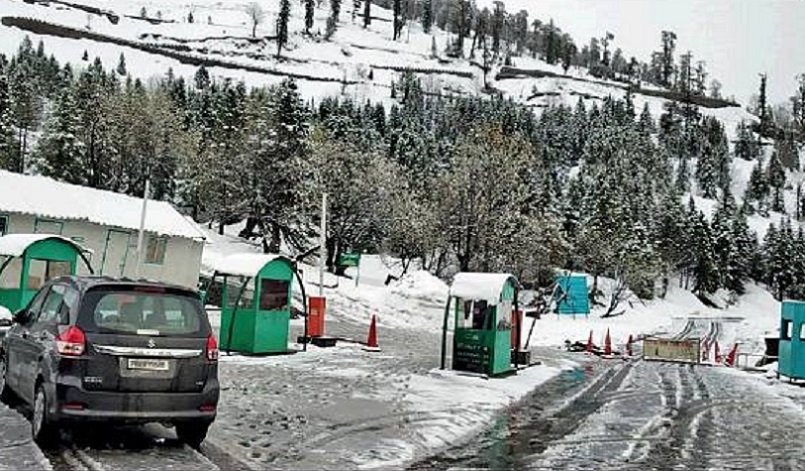
From The Times of India
See graphic, ' Manali witnessed rare snowfall on 17 April 2019 '
18th April
Delhi 30.7°C/ 17.1°C, 2019
After rain relief, temp to rise today | The Times of India
After two days of rain and thundershower, the city saw a sunny Thursday with the mercury clocking below the season’s standard. The maximum and minimum temperatures on Thursday were 30.7 degrees Celsius — six notches below normal — and 17.1° Celsius, five points below normal, respectively.
19th April
20th April
21st April
22nd April
23rd April
24th April
25th April
Delhi: 41°C/ 2018
2018 Delhi: Hottest day of season at 41 degree C, rain likely on Friday
TNN | Apr 26, 2018
It was Delhi’s hottest day of the season so far, as mercury levels crossed 43 degrees Celsius for the first time this season at Palam. Safdarjung – considered as the base for Delhi’s weather — also recorded its highest maximum temperature of the season so far, at 41.6 degrees Celsius.
According to met officials, Palam was the hottest across the capital on Wednesday with a maximum of 43.1 degrees Celsius, however other locations recorded similar season highs. The Ridge station recorded a maximum of 42.6 degrees C, while Ayanagar had a high of 42.4 degrees C, officials said.
26th April
Delhi/ Palam, 43.9°C, 2018
2018: the maximum temperature high of 41.6 degrees Celsius to be recorded at 42 degrees Celsius at Safdarjung – three notches above normal for the season.
This was also the season’s highest at Palam where the maximum temperature touched 43.9 degrees Celsius. Maximum temperature at Ayanagar was 42.4 degrees Celsius, while Lodhi Road and Ridge recorded 40.4 and 40.6 degrees Celcius respectively.
On Thursday, along with the intense heat, the humidity also remained high oscillating between 26 and 88% in the last 24 hours.
27th April
28th April
29th April
Delhi: 40>42.2°C; rain, thunder /2018
2018: Rain cools city
The capital received some much needed respite on Sunday night with intense rain and thunder reported from several parts of the city. While the day-time temperature remained high, with the maximum temperature recorded at 40.4 degrees Celsius at Safdarjung, it crossed the 42 degree Celsius mark at Palam on Sunday. Met officials attributed the rain to favourable local conditions, saying it was normal for this time of the season to see such rain. These showers usually develop within a matter of hours, officials added. “There was rapid local development, which is a typical characteristic of thunderstorm activity in the pre-monsoon season. We had an active circulation from northeast Rajasthan that came to the capital by the evening, while the moisture content was already high,” said Kuldeep Srivastava, scientist at the regional met office.
On Sunday, mercury levels were above the 40 degree Celsius mark at all stations in the capital, with Palam being the highest at 42.2 degrees C. Ayanagar, Ridge and Lodhi road, meanwhile, recorded a maximum of 41.2, 40 and 40 degrees Celsius respectively.
30th April
See also
January weather in India <> February weather in India <> March weather in India <> April weather in India <> May weather in India <> June weather in India <> Summers: India<> Heatwaves: India <>July weather in India <> August weather in India <> September weather in India <> Monsoons: India<> October weather in India <> November weather in India <> December weather in India <> Winter rains: India <> Winters: India <> Heatwaves: India


